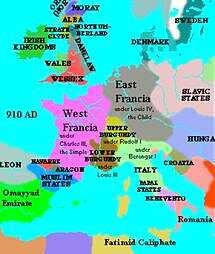
Upper and Lower Burgundy in the 10th century
Following his ascension to the throne in 912, Rudolf II was asked by several Italian nobles to intervene in Italy on their behalf against Emperor Berengar in 922. Having entering Italy, he was crowned King of the Lombards at Pavia. In 923, he defeated Berengar at Piacenza; Berengar was murdered the following year, possibly at the instigation of Rudolf. The king then ruled Upper Burgundy and Italy together, residing alternately in both kingdoms.
However, in 926 the Italian nobility turned against him and requested that Hugh of Arles, the effective ruler of Provence (or Lower Burgundy), rule them instead. Rudolf returned to Upper Burgundy to protect himself, assuring Hugh's coronation as King of Italy in the process. The Italians then switched sides again, declaring that they wished for Rudolf to reclaim the throne. To prevent this, Hugh and Rudolf signed a treaty in 933, granting Rudolf rule of Lower Burgundy in exchange for his renunciation of all claims on the Italian throne. The two Burgundian kingdoms unified, Rudolf ruled until his death in 937. He was succeeded by Conrad.
In medieval times respectively a kingdom and a duchy, later a province of France (to 1789), and now represented mostly by the departments of Ain, Saône-et-Loire, Côte-d'Or, and Yonne. It has nearly 2,000,000 inhabitants, and is famous for its diversified scenery, its rich wines, its rivers and canals, varied industries, mineral wealth, and many prosperous cities. In the fifth century a Germanic tribe, the Burgundi or Burgundiones, conquered from the Romans the fertile basins of the Rhone, the Saône, and the Loire, but were unable to maintain their sovereignty, which in the next century they lost (534) to the Frankish successors of Clovis.
|
In the latter quarter of the ninth century this territory again acquired independence, first as the short-lived Kingdom of Arles, and then as the dual Kingdom of North and South Burgundy, the latter including Provence or the lands between Lyons and the sea, while the former took in, roughly speaking, the territory north of Lyons, now divided between France and Switzerland. These kingdoms, known as Transjurane and Cisjurane Burgundy, were reunited (935) under Rudolf II.
The independence of this "middle kingdom", the medieval counterpart of modern Switzerland, was short-lived, for in 1038 Emperor Conrad II obtained the crown of Burgundy for his son (later Emperor) Henry III. For two centuries German influence was uppermost in the counsels of the Burgundian rulers, but little by little the growing prestige and power of neighbouring France asserted themselves, beginning with the annexation of Lyons by Philip the Fair in 1310 and ending with that of Savoy and Nice in 1860. During this time, in language, laws, and institutions Burgundy became regularly more closely assimilated to France, and finally an integral part of that nation when, on the death of Charles the Bold (1477), Louis XI incorporated with France the Duchy of Burgundy and extinguished thereby, in favour of the royal prerogative, one of the most important fiefs of the French Crown